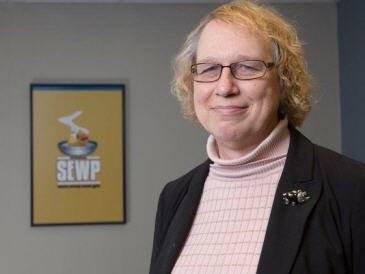

Joanne Woytek, the NASA SEWP program director, said the governmentwide acquisition contract grew 25% in March as compared to the previous month and saw 40% more...
Best listening experience is on Chrome, Firefox or Safari. Subscribe to Federal Drive’s daily audio interviews on Apple Podcasts or PodcastOne.
NASA’s acquisition office that runs the SEWP governmentwide acquisition contract (GWAC) hasn’t missed a beat even during this time of remote working and a surge in contract use.
This is because the SEWP program office literally had a fire drill last year. A small electrical fire in the basement of its building forced employees to work from home for about a week.
Joanne Woytek, the NASA SEWP program director, said the program office staff was well-prepared to telework and now is focusing on trying to make acquisition easier for agencies by using a tool typically saved for the busy federal fourth quarter buying season.

“When we started interacting with some of our customers with emergency needs because of the coronavirus issues, they were asking if they could get quicker turnaround. Our default outside of September is usually a minimum of three days for a request for quotes. We did decide to switch to allow for that one day turnaround as we do in September,” Woytek said in an interview. “This is not so much to say people are going to respond quicker to every possible RFQ. The companies still need time to do their work and respond with a quote. But if everything is lined up and it’s a real emergency and the government customer has done everything they can to get it in a one-day turnaround situation and industry is ready for it, we wanted to make sure we weren’t getting in the middle of things to allow for that one-day turnaround.”
Woytek said she doesn’t expect the one-day turnaround to be used too often, but it’s a tool to help meet specific coronavirus response needs.
SEWP, which doesn’t issue orders for agencies, is just ensuring its processes are getting in the way of its customers.
At the same time, Woytek said SEWP must ensure the lines of communication remain open with their customers and vendors, particularly around emergency acquisition authorities like the raising of the micro-purchase (MPT) and simplified acquisition (SAT) thresholds. The Office of Federal Procurement Policy raised both buying thresholds in March — MPT to $20,000 from $10,000 and SAT to $750,000 from $250,000 for purchases made in the U.S.
Since the beginning of the pandemic, Woytek said some interesting trends have started to emerge compared to last year at this time. She said SEWP remains a popular contract. NASA estimates SEWP will handle at least 50,000 orders or modifications in fiscal 2020.
“SEWP has been growing at a phenomenal rate over the last four or five years, a 20%-to-25% growth rate. We continue to see that,” Woytek said. “This past month [March] was a very good one. We grew 25% as compared to last month and we saw 40% more orders going through [the] system, with a busy time especially near end of March.”
The other big trend SEWP has experienced over the past month or so is growth in specific products from companies.
“There were three interesting companies in terms of where they are now, much higher in our list of usage than last year: Citrix, a virtual workstation desktop, McAfee, which does a lot of security, and IBM. When I looked at what items we added to IBM’s list in the past six months it was around virtualization and storage capabilities,” she said. “Clearly a lot more going through because those three companies moved from a much lower ranking of usage last year to where they are over the past six months. I can’t say it’s directly tied to the virus, but one could make a reasonable guess that there is some correlation between the two.”
Woytek said SEWP also has addressed other challenges around possible technology supply chain disruptions and the need to respond and react to the stimulus money that has to get out the door.
“The people who need to get things, there are ways to get them either through SEWP or any of the other contracts out there. The government and industry are still working,” she said. “I think everyone has been good about understanding that this is a different world and we have to adjust to it.”
Beyond the coronavirus challenges, Woytek said SEWP continues to move forward with new processes and approaches.
She said over the last year SEWP developed an approach to create agency specific catalogs of products so customers can find approved technology hardware and software more easily.
The first one was for those products approved by the NASA CIO, but Woytek said her office is working on similar catalogs for other agencies.
“Another area we started last year that has been fortunate in terms of timing because having connections with industry has proved to be important. We have a new industry team. We started about a year ago with one person and now it’s a team of people. They are working with the 400-plus companies that have products and services on SEWP and letting the rest of the companies who are not yet on SEWP.”
A third priority for 2020 is building up SEWP’s customer relationships.
Woytek said SEWP is building a team of customer experience experts who will look at what the organization can do today to improve and what it needs to do over the next five years.
“What is something that is beyond what people are thinking on to improve the customer experience,” she said.
Copyright © 2025 Federal News Network. All rights reserved. This website is not intended for users located within the European Economic Area.
Jason Miller is executive editor of Federal News Network and directs news coverage on the people, policy and programs of the federal government.
Follow @jmillerWFED

